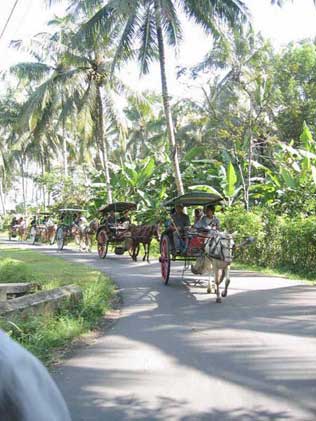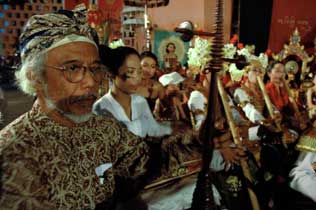Metakaruna in Semarang: Central Java, Indonesia
Andre Pratama pulled up in front of the headquarters of the 4th military regional command of Diponegoro on Jl. Perintis Kemerdekaan, Semarang, last week when, on his way from Solo to Jakarta, he decided to take a brief rest after noting an imposing building on the right side of the road about five kilometers before entering Semarang.
He saw, right across from the military headquarters, a tall building, each floor of which had a horse saddle-shaped roof and a lot of statues. Andre and his family left the car just to have a look at the building, whose colors and unique shape caught their attention.
This building is called Avalokitesvara or the Metakaruna Pagoda. As meta, a Pali word means love and karuna, another Pali word, means affection, metakaruna is usually understood to mean loving kindness. So, it is a seven-story pagoda of loving kindness, located in the same compound as Buddhagaya Temple in Watugong. This 45-meter pagoda looms high in the vicinity.
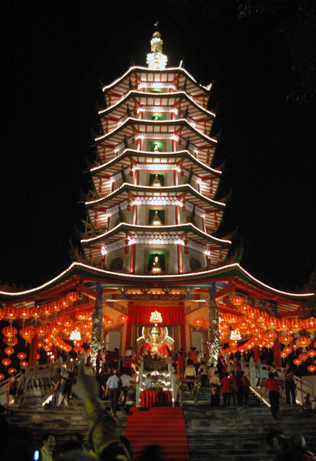
“It is really beautiful. I did not realize that there was a pagoda in Semarang until the building was completed. In fact, I often pass this road,” said Andre, 45, a resident of Solo.
This pagoda is a new landmark for Semarang, after the Sam Poo Kong Temple in Gedung Batu, Simongan, Semarang, the renovation of which was completed in 2005.
In fact, there are several other places of worship that may lure visitors to Semarang. The oldest is Blenduk Church of Emmanuel in Kota Lama, then the Grand Mosque of Semarang, the Sam Poo Kong Temple, Tay Kak Sie Temple and the Semarang Cathedral.
Chairman of the committee for the pagoda construction, Po Soen Kok, said that the pagoda construction began in August 2005 and that some Rp 1 billion had been spent on its construction.
“The construction was planned to be completed in eight months but in fact we needed two more months because many of the building materials and the statues had to be imported directly from China,” he said.
The pagoda, which is open to the public, is actually a special place for those wishing to worship and make a prayer to Kwan Im Poo Sat or the Goddess of Mercy (Kuan Yin).
Well, what is special about this pagoda?
The first impression for a visitor is that it is just like a Buddhist pagoda moved here directly from China. The Chinese ornaments, relief decorations and statues are all imported from China. That is why it looks so unique and attractive in Semarang. In fact, it is home to some 30 beautiful statues.
The highest level of the pagoda is home to four statues of Amitaba or the deities and great masters of the Buddhists. At the very top of the pagoda, you can find a statue of the Buddha, a bodhi tree and a place of worship.
The base of the building is octagonal in shape and measures 15 meters by 15 meters. From the second level up to the sixth you can find the statues of the Goddess of Mercy Kwan Im Poo Sat facing all directions: west, east, north and south. On the first level, you can find four different statues of the Goddess of Mercy. This pagoda has a total of 25 statues of the Goddess of Mercy.
“The statues of the Goddess of Mercy face all the directions so that she can always spread loving kindness in all directions and maintain peace among the residents of Semarang,” said chairman of Watugong Budhagaya Temple Foundation, Halim Wijaya.
A statue of the Goddess of Mercy carrying a lotus flower, for example, is intended for those making a prayer to this goddess in order to find a life-partner. Meanwhile, visitors wishing to have a daughter, for example, will pray to the statue of the Goddess of Mercy carrying a girl. The Goddess of Mercy carrying a boy is for those wishing to have a son. There is also a special statue of the Goddess of Mercy for those wishing to live a long life.
On the first level of the pagoda, there is a big statue of the Goddess of Mercy measuring 5.10 meters in height facing Semarang city. It is placed there so that Semarang residents can be protected against disasters. Then there is another giant statue of Commander We Do, the guardian of the pagoda and the protector of people’s safety.
Why does the pagoda have seven levels?
Level seven is believed to be the highest level of holiness that can be attained by a monk. The pagoda is 45 meters high, a symbol of the achievement of the highest level of material life.
For the Chinese, Halim said, 45 is an auspicious number because when you put together 4 and 5 you get 9, the highest number and therefore the symbol of good fortune and the highest achievement. “That’s why many Chinese businessmen like the figure 9 very much. For this reason, many car plate numbers or cellular telephone numbers end with this figure,” he added.
As it is very high, the pagoda looks narrow. Still, the building has been designed to be earthquake-resistant. Therefore, this pagoda, which was inaugurated on July 14, 2006 by Central Java Deputy Governor Ali Mufiz is safe to visit.
Visitors coming to this pagoda can admire the stone staircase in the shape of nine dragons, the dragon lamps, the dragon pool, the dragon fountain and even the statues of a phoenix and a Chinese mythological animal that looks like a lion. All the stone has been imported from Fujian province while the copper from Tung Guan, China.
Po Soen Kok added that the building of this pagoda, the most imposing to date in Indonesia, is expected to unify people of various faiths to achieve religious harmony.
“It is a religious teaching that can create interfaith harmony. In turn, religious harmony will lead to lasting peace in Indonesia and in the world,” he noted.
Po also expressed the hope that this pagoda would become a tourist site, just like Borobudur Temple. Those wishing to pray there or just look around are free to come and go. However, there is one place that the public are barred from entering, that is Kuti, which is where the Buddhist monks sleep. Buddhist monks are Buddha’s disciples so not everyone is free to enter their abode.
It is very likely that this pagoda will become a tourist site especially because Sangha Therawada Indonesia, one of the main Buddhist groups in Indonesia are planning to observe four holy days there.
The first holy day is Maghapuja, which is observed in March. About 1,250 Buddhist monks will gather to pray to Lord Buddha. Then Waisak in May, which is always observed on a full moon. When observing Waisak, Buddhists observe the birth of Buddha, His achievement of perfect enlightenment and His demise or His going to Nirvana.
The third holy day is Ashada, which is observed in July. On this day, Buddhists observe the first day Buddha taught his five disciples after he achieved enlightenment.
The fourth holy day is Khatina in October. Actually, the Khatina is originally observed during winter, when Buddhist monks perform wasa or live in the temple for two or three months. During their wasa Buddhist monks stay in the temple to meditate and study Buddhist teachings.
Besides these four Buddhist rites, there are also three other rites to be observed in this pagoda (all in the Chinese lunar calendar): 19th of the second month, which is the birthday of the Goddess of Mercy, 19th of the sixth month, which is the day when the Goddess of Mercy achieved enlightenment, and 19th of the ninth month, which is the day when the Goddess of Mercy went to Nirvana.
Central Java Governor Mardiyanto in his written address in the ceremony marking the inauguration of this pagoda stressed that the pagoda, the first in Indonesia, was expected, along with the Borobudur Temple, to be able to unify all Buddhist sects in Indonesia.
“The fact that there are 30 Buddhist sects in Central Java may cause differences although all these sects are based on Buddhism,” he noted.
Suherdjoko
Label: central java

![© Carolyn Leigh, 2005. All rights reserved. [White water buffalo hide of unpainted wayang kulit puppet gives a lacy effect: 42k]](http://www.art-pacific.com/images/waykhide.gif)
![© Carolyn Leigh, 2005. All rights reserved. [Karno, detail of face: 21k]](http://www.art-pacific.com/images/waykarno.gif)
![© Carolyn Leigh, 2005. All rights reserved. [Dursosono, detail of face: 26k]](http://www.art-pacific.com/images/waykdurs.gif)
![© Carolyn Leigh, 2005. All rights reserved. [Semar: 20k]](http://www.art-pacific.com/images/waykseym.gif)

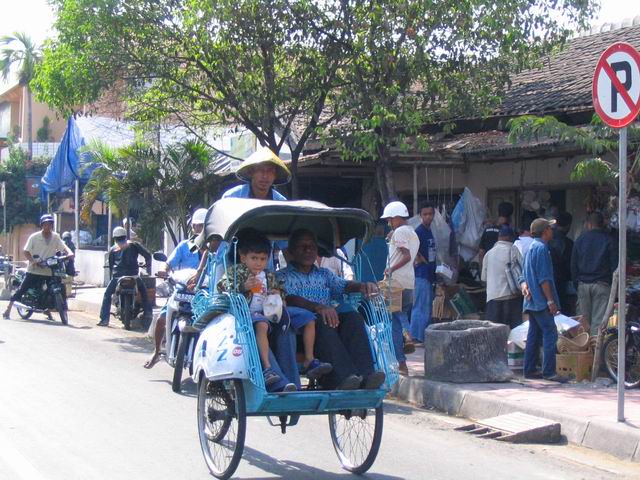




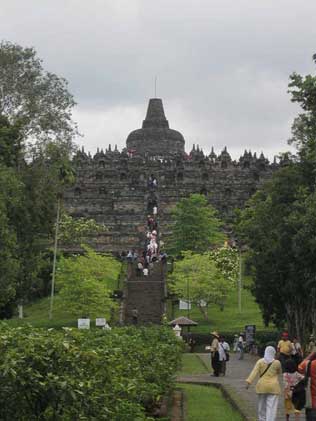 There is no doubt that the beauty, glory, and magnificence of the world heritage site, Borobudur temple, is well known not just across Indonesia but also around the globe. Yet, little may be known about the surrounding areas that are no less interesting destinations and can be enjoyed while visiting Borobudur — the largest Buddhist temple in the world built around the 7th and 8th centuries, located some 60 kilometers north of Yogyakarta.
There is no doubt that the beauty, glory, and magnificence of the world heritage site, Borobudur temple, is well known not just across Indonesia but also around the globe. Yet, little may be known about the surrounding areas that are no less interesting destinations and can be enjoyed while visiting Borobudur — the largest Buddhist temple in the world built around the 7th and 8th centuries, located some 60 kilometers north of Yogyakarta. 